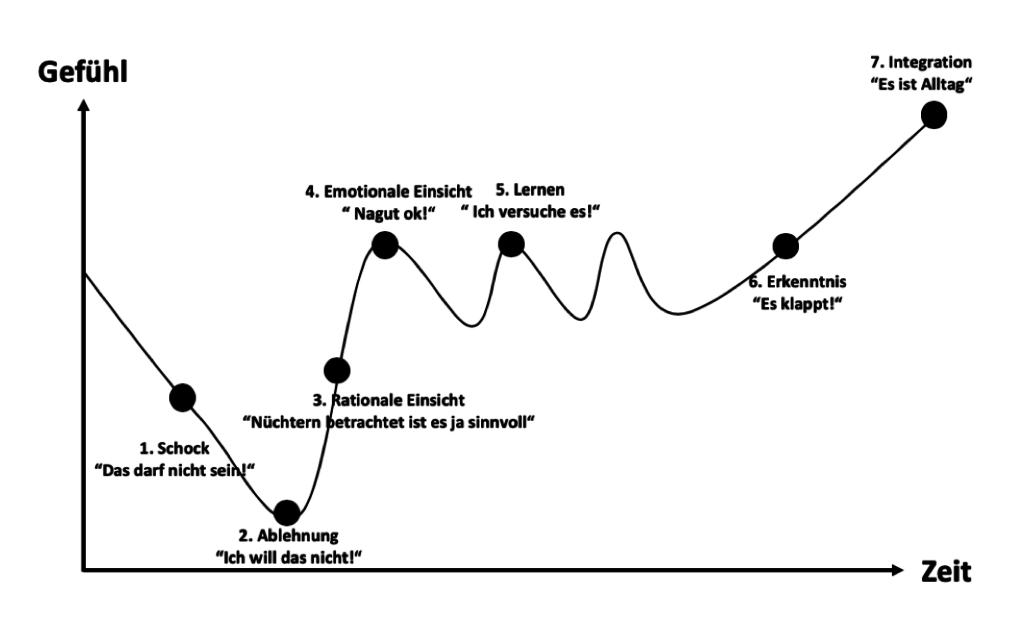I have been asked a lot lately about strategies for change in the company and how agility can be carried in 100% of the areas of the company. My first answer is of course: 100% agile is unlikely to exist and agility doesn’t actually need a special change strategy. Agility can be seen in exactly the same way as the introduction of a product, or it can be introduced in the classic way according to Kotter’s change strategy.
Every model has its origin in the considerations of Kurt Lewin, who classified a change in three phases in 1943. Basically, two forces work in organizations:
- own security strivings and habits that demand the maintenance of the status quo
- new technologies, executives new competitors who demand changes
Kurt Lewin then established in 1947 that change only takes place as soon as the force of necessity for change is stronger than that of habit. Richard K. Streich then discovered that there are seven phases that employees go through when they find out about a change:

Phase 1: shock
The need for change creates a shock through fear of a new situation. This leads to an inability to rationally reflect on the change. My recommendation during this time: communicate the change and then let the employees digest the shock for 1-2 weeks. They just announce that new changes are being introduced.
Phase 2: rejection
The shock is followed by strong rejection. You will notice this phase when employees start talking negatively about the change. In this phase, you as a manager should help the employees to understand why the change is being made and thus prepare for phase 3. Explain the drivers of change. See yourself as an advocate for change.
Phase 3: Rational Insight
After it is recognized that rejecting a change does not help, employees start to deal with the change rationally. You start to weigh up the advantages, take in the first information about the change and would like the first short-term steps to implement it. At this stage, communicate initial information on how to implement the change, but not the entire plan.
The difference between rational and emotional insight can be illustrated very well using the example of a fitness studio. I realize that I’m too fat based on data like body weight (rational insight) but I don’t go to the gym because I don’t want to (emotional insight).
Phase 4: Emotional insight
The emotional insight is the real turning point and it means for you as a manager to stay tuned. Employees begin to become familiar with the change and show themselves openly. In this phase, it is important to grant concrete project plans and initial test access to possible software tools.
Phase 5: learning
The employees have accepted the change and are starting to try out the new software tools and virtual working methods. Release initial training courses on software and methods as well as initial written guidelines for employees. Let the first teams work with the new processes or software tools.
Phase 6: realization
Have the employees fast in phase 5 Successes achieved with the software tools, these will change very quickly want to gradually adopt them in their everyday lives. Hire a nice administrator to assist you with using the software and ask for feedback to new processes by a process manager.
Phase 7: integration
Now the new software tools and way of working are taken for granted. Your task as a manager is now like a kind of “senior teacher” to monitor whether the new working methods are still adhered to after 2-3 weeks and relapses into old behavior are avoided.
Model by Rogers
Every employee goes through these phases. Some of them faster (even in a split second) and others in many years or never. Now my idea in agile transitions is always: I start with employees who have already gone through these phases (at least up to phase 4). But how can you tell?
I like to use Rogers’ (1992) model. “ The diffusion theory of the communication scientist Everett Rogers explains the development of innovations and especially their spread on the market. Diffusion occurs because innovations such as new services or products are usually adopted with a delay. “ (Source: onlinemarketing.de ). I would now like to apply this theory to my last agile change. An introduction based on the Kotter model can be found in Articles on organizational rebels.
Further reading tip: Agile change according to Kotters change model

Phase 0: management
For me, the “go” (yes, we want to become agile) from top management is the most important basic requirement and I assume that you already have it. If not, it will be difficult or impossible to get started.
If you don’t have this go yet, you should show management the necessity, change plan and opportunities for agility through presentations, workshops and much more. This can be a very long and arduous process and requires patience.
Phase 1: innovators
In the first phase, it is advisable to set up the first agile pilot teams. Hardly any change is necessary. The tip is: Just ask: Who is interested in agile work and would like to be in the first pilot team? According to the theory, you will be able to attract 2.5% of your employees without any change effort. Now it is important to monitor compliance with the agile methods.
Your company is 2.5% agile at this point.
Phase 2: Early adopters
Now, on the one hand, ask the innovators to tell others about the project and also communicate in the blog etc. about the successes of the agile teams. You will notice that a further 13.5% (according to the theory) now want to work agile without much change effort. Due to the higher number of employees, it is now necessary to conduct intensive coaching and to adapt processes in the company. This phase should take a few months. As a manager, you have to monitor compliance with agile processes and behaviors almost like a senior teacher through coaching, role model function and perseverance. During this time, the eyes of the entire organization are on the agile teams.
Your company is 15% agile at this point.
Phase 3: early majority
Now it’s time to take the early majority with you. This can usually be influenced by the innovators. So you have to keep your opinion leaders “happy” on the one hand and engage in talks with the early majority on the other. In this way you can win over one employee at a time – piece by piece. This process takes a few months and, according to the theory, you will gain a further 34% for the new agile way of working. This phase can easily take more than 1 year.
Your company is 49% agile at this point.
Phase 4: Late majority
Now almost 50% of your company is largely agile. The task now is to attract more employees. This phase should last at least 1-2 years. My experience is: You will not win all 34% in this phase, but with the help of discussions and agile coaches you can certainly win half, i.e. around 17%. Phase 5 shows why you don’t all win.
Your company is 66% agile at this point.
Phase 5: latecomers and late majority
In contrast to innovations, not everyone will want to work in an agile manner. Especially in medium-sized companies, if you put too much pressure on, they will simply quit. If specialists simply do not feel like agility, then they will also find an employer who does not work agile.
But don’t worry: not all areas have to be agile and flexible. So create customers and teams that don’t need agility. You will surely gain a few more% in this phase, but not much will change. The cost / benefit effort is simply too high for a further transformation here.
Your company is 68% agile at this point.
Conclusion: 4 years of agile transformation in a nutshell
In this blog article I have summarized 4 years of agile transformation very briefly. I don’t think that a company has to be 100% agile and I don’t know whether the% values are correct either, but I wanted to orientate myself on theory. I think that a change to 50% – 60% agility after 4 years is an absolute success and is absolutely sufficient for the current time.
[werbung] [fotolia]


